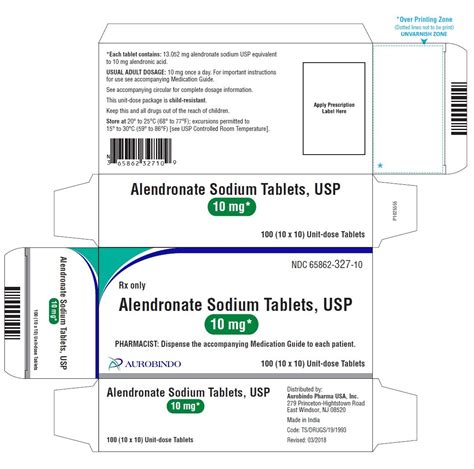Alendronate, commonly known by its brand name Fosamax, is a medication that belongs to a class of drugs called bisphosphonates. It is primarily used to treat and prevent osteoporosis, a condition characterized by weakened bones, making them more susceptible to fractures. Osteoporosis can occur in anyone, but it is more common in postmenopausal women and older men due to the decrease in estrogen and testosterone levels, respectively, which are hormones that help maintain bone density.
How Alendronate Works
Alendronate works by inhibiting osteoclast-mediated bone resorption. Osteoclasts are cells responsible for breaking down bone tissue, a process that is essential for bone remodeling but can be detrimental when it occurs excessively, as in the case of osteoporosis. By reducing the activity of these cells, alendronate helps to maintain or increase bone mass and mineral density, thereby reducing the risk of fractures.
Conditions Treated by Alendronate
Osteoporosis in Postmenopausal Women: Alendronate is used to treat osteoporosis in women who are past menopause. It helps to increase bone mass and reduce the risk of fractures, particularly in the spine and hip.
Osteoporosis in Men: It is also used to treat osteoporosis in men, helping to increase bone mineral density and reduce the risk of fractures.
Glucocorticoid-Induced Osteoporosis: Patients who are on long-term glucocorticoid (steroid) therapy are at risk of developing osteoporosis due to the bone-thinning effect of these medications. Alendronate can be used in these cases to prevent and treat glucocorticoid-induced osteoporosis.
Paget’s Disease of Bone: Alendronate is used to treat Paget’s disease, a condition characterized by an abnormal breakdown and regrowth of bone tissue, leading to deformity.
Administration and Dosage
Alendronate is available in tablet form and is usually taken once a week, with a full glass of water, on an empty stomach, and at least half an hour before eating or drinking anything else. It’s crucial to follow the dosing instructions carefully to minimize the risk of side effects, particularly those affecting the esophagus.
Side Effects and Precautions
While alendronate can be very effective, it is not without potential side effects. Common side effects include:
- Abdominal pain
- Nausea
- Vomiting
- Constipation
- Diarrhea
- Headache
- Muscle pain
More serious side effects, though rare, can include esophageal ulcers, osteonecrosis of the jaw, and atypical fractures of the thigh bone. Patients with pre-existing kidney problems should use alendronate with caution, and it is not recommended for patients with severe kidney disease.
Lifestyle Modifications
In addition to taking alendronate, patients with osteoporosis are often advised to make lifestyle modifications to further improve bone health. These include:
- Engaging in regular weight-bearing and muscle-strengthening exercises
- Quitting smoking
- Reducing alcohol consumption
- Eating a balanced diet rich in calcium and vitamin D
- Considering supplements if dietary intake of calcium and vitamin D is inadequate
Conclusion
Alendronate is a valuable medication for the treatment and prevention of osteoporosis and related conditions. While it offers significant benefits in terms of reducing fracture risk and improving bone density, it must be used under the guidance of a healthcare provider, with careful consideration of potential side effects and the need for concurrent lifestyle changes to maximize its effectiveness.
What are the main uses of alendronate?
+Alendronate is primarily used to treat and prevent osteoporosis in postmenopausal women and men, as well as glucocorticoid-induced osteoporosis and Paget’s disease of bone.
How does alendronate work?
+Alendronate works by inhibiting the activity of osteoclasts, cells that break down bone tissue, thereby maintaining or increasing bone mass and mineral density.
What are the potential side effects of alendronate?
+Common side effects include abdominal pain, nausea, and muscle pain. More serious side effects, though rare, can include esophageal ulcers and osteonecrosis of the jaw.
How should alendronate be taken?
+Alendronate should be taken once a week, with a full glass of water, on an empty stomach, and at least half an hour before eating or drinking anything else.
What lifestyle changes can complement alendronate treatment?
+Patients are advised to engage in regular exercise, maintain a balanced diet rich in calcium and vitamin D, quit smoking, and reduce alcohol consumption to further improve bone health.


